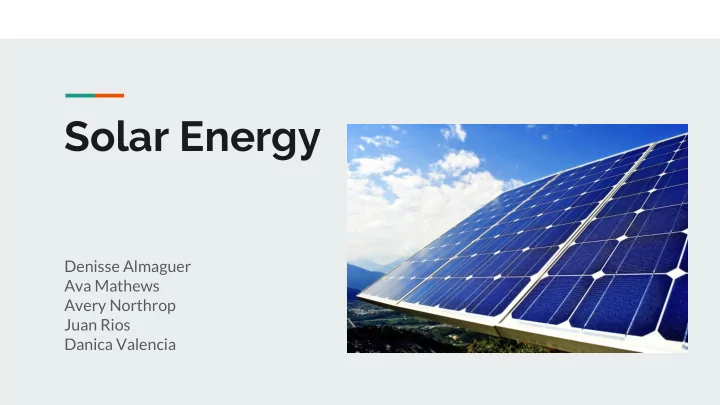

Solar Energy Denisse Almaguer Ava Mathews Avery Northrop Juan Rios Danica Valencia
Effects of Fossil Fuels Economies rely on conventional fuels ● (coal, oil, natural gas) to meet fast paced growth in energy demand Power generation produces ● 530gCO2/kWh on global average Global temperatures have increased ● because of greenhouse gas emissions
Growing Emissions Developed countries ● have produced majority of anthropogenic greenhouse gas emissions Developing countries ● have recently increased GHG emissions, surpassing the levels from developed countries
Growing Energy Demand Worldwide energy demand is ● expected to rise by 1.5-3 times, by 2050 Energy demand is rapidly ● increasing due to rapid population growth, especially in Africa and Asia
Environmental Concerns Consequences of temperatures rising higher than 2 ℃ annually ● Additional 250,000 deaths worldwide between 2030 and 2050 ● Less snow and ice cover ● Economic losses of between 4% and 20% GDP ●
Transition to Solar Implementing different energy ● sources could alleviate the effects of economic development on the environment Renewable energies are accessible ● to many areas around the world Solar energy is inexhaustible and ● pollution-free form of energy
Photovoltaics Four Kinds of Photovoltaics Single Crystal ● Expensive. Not used are much. Have a 23% Efficiency. Take more energy to manufacture than they produce ○ in their lifetime Polycrystalline silicon ● Most popular and has a 20% efficiency, cheaper ○ Thin films ● Up & coming. Modular, and is the Cheapest and lights ○ High efficiency photovoltaics(HEPV) Triple junction Gallium Arsenide ● >40% $50,000/m High efficiency, but very expensive, used in space crafts ○
How does it work? Silicon Solar Cell Has two layers of silicon that consist of N type( has extra electrons) P type (has extra spaces). ● Photon strikes the silicon with enough force to knock the electron from its cell at same time while ● leaving a hole. The electric magnetic field from the N/P junction helps the free electron flow to the N side and the ● hole to the P side where they are collected through small metal fingers at the top of the cell. From there the electrons flows through an external circuit, where the electron does electrical work ● are before returning through a conductive aluminum sheet.
Concentration of Solar Energy Four types of methods Parabolic Trough ● Uses trough shape mirrors usually on a single axes. ○ Parabolic Dish ● Very high conversion efficiency, up to 30%. Use multiple mirrors on two axes. ○ Solar Tower ( Heliostat) ● Uses a field of mirrors called "heliostats" that individually follow the sun on two axes, ○ and reflect sunlight to a receiver at the top of a tower. Lens ● Uses flat mirror arrays to reflect sunlight onto elevated linear absorbers or ○ receiver tubes Can be used with Turbine, Stirling, and HEPV
Utilizing Solar Energy Solar transportation ( Cars, Buses, Boat, and Space Crafts) ● Solar Appliances ( Cooker, Dryer, Powered Fan, Air Conditioning) ● Solar domestic and public lighting (Lamps, Flashlights, street Light, Traffic Light) ●
Pay Back Cost for Solar Panels ($30,000-$10,000)/($1,200+$1,500)=7.4 years Upfront Gross Cost of Annual Additional Incentives System Savings Incentives
Solar Energy Benefits: Economics Solar technology has rapidly ● decreased in price, more than all other renewable energies Despite the high up-front costs ● to installation, both commercial and residential units save money over time No decrease in productivity due ● to using solar over fossil fuels
Solar Energy Benefits: Environmental Every 1 GW of extra renewable energy capacity has ● vast potential to reduce carbon dioxide emissions, on average, by 3.3 million tons each year. The earth's surface receives large amounts of ● energy from the sun enough to provide 7900 times as much energy as the ○ world's population currently uses. It is estimated that solar power could produce 22% ● of the global electricity by 2050. This would eliminate a remarkable portion of the increasing global carbon dioxide emissions
How to Implement Solar: Challenges Installation costs ● Low price of fossil fuels ● Low Government Support ● Government subsidies for fossil fuels ○ Public ignorance of the need for renewables ● Dust ● Lack of infrastructure needed to support Solar ● particularly in developing countries where ○ implementation of renewables is important reduces output power from photovoltaic systems ○ from 2% to 50%
How to Implement Solar: Overcoming Challenges Feed in Tariffs ● Essentially pays people for creating ○ their own green energy Capital subsidies ● International Aid ● Carbon Tax or Cap-and-Trade ● Increasing Awareness of the need for ● renewable s
Policy In order to have Solar success, developing countries ● need to subsidise the use of renewable energy technology, especially solar and the research of solar Implement feed-in tariffs ○ Use international aid for development ○ Increased education about the danger of continuing to ● use environmentally harmful technologies like coal power production and oil
Solar Environmental Concerns Land Use large scale PV ● Visual Impact ● Sensitive Lands for CSP ● Increasing Erosion ●
Environmental Justice In 2012 indoor air pollution was responsible for 4.3 million ● deaths Deforestation threatens their livelihood, destroys ecosystems ● and habitats, accounts for 15% of GHG emissions 600 million people in Africa don’t have access to modern energy ● services Developing countries have high potential to receive enough ● solar radiation as a result of their geographical location in comparison to developed countries.
Environmental Justice Benefits: information, education, ● entertainment, better quality of life, creation of wealth 1.3 billion people do not have access to ● electric power Proper lighting increases safety, productivity ● For rural areas where grid connectivity is not ● possible, off grid solutions like solar are more economically achievable
Solar Installation
Solar Installation
References 1. https://www.livescience.com/41995-how-do-solar-panels-work.html 2. https://www.greenmatch.co.uk/blog/2015/09/types-of-solar-panels 3. https://www.sciencedirect.com/science/article/pii/S1364032118301527 4. https://www.researchgate.net/publication/268983770_Solar_Energy_in_Sub-Saharan_Africa_The_Challenges_and_ Opportunities_of_Technological_Leapfrogging 5. https://qz.com/africa/1238545/the-biggest-obstacle-to-deploying-solar-energy-in-africa-is-skepticism-in-high-plac es/ 6. https://www.pv-tech.org/news/bill-gates-solar-is-not-the-energy-solution-africa-needs 7. https://www.resilience.org/stories/2018-04-06/solar-power-in-africa/ 8. http://isolaralliance.org/docs/GetTogether/Eighth%20Get%20Together/CUTS%20International.pdf 9. https://www.epa.gov/energy/greenhouse-gases-equivalencies-calculator-calculations-and-references 10. http://files.sma.de/dl/7680/SMix-UEN091910.pdf 11. http://cleanenergyaction.org/learn-more/feed-in-tariffs/ 12. https://www.huffingtonpost.com/pierce-nahigyan/solar-power-is-freeing-ru_b_10564586.html 13. http://files.udc.edu/docs/cere/Solar%20Power%20and%20Sustainability%20in%20Developing%20Countries.pdf
Recommend
More recommend